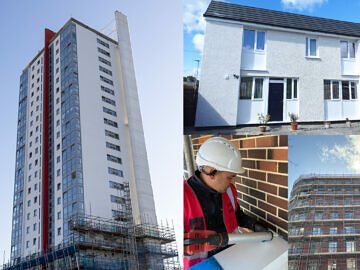Daniel Mackie, Director at Hamilton has issued an urgent call for action to speed up works on unsafe buildings. He said:
“As the government’s efforts to tackle unsafe cladding in buildings across the nation gain momentum, it is imperative to address the concerning delays and challenges hindering progress. The commitment to transparency through regular updates on the government website is commendable. However, the latest data reveals a sobering reality – many buildings are yet to see remediation work commence, putting countless lives at risk.
The government’s publication of various statistics and datasets on building safety remediation provides valuable insights into the scale of the challenge. Yet, amidst the numbers and metrics, it’s evident that significant gaps remain in addressing the urgency of the situation.
One of the fundamental challenges lies in the diverse pathways available for remediation, including taxpayer-funded schemes, developer-led initiatives and social housing provider-led efforts. While each scheme aims to address specific aspects of the problem, the pace of progress varies, contributing to disparities in remediation rates across different programmes.
As of February 2024, the data paints a concerning picture. Out of 4,092 residential buildings above 11 metres identified with unsafe cladding, a staggering 56% have yet to commence remediation. This means over 120,000 households continue to live in buildings deemed unsafe.
The statistics further reveal discrepancies in remediation progress across different programmes, although I believe this can be mainly attributed to the length of time they have been available. The ACM Cladding Remediation Programme, which has been monitoring buildings since 2017, boasts an 87% completion rate, while the Cladding Safety Scheme, which was fully opened in July 2023, has no buildings completed and only 1% started.
It’s evident that urgent action is needed to address the backlog of buildings awaiting remediation. The estimated 6,200 to 8,900 buildings between 11 and 18 metres in height requiring remediation underscore the magnitude of the challenge. These buildings represent not just structures but homes and communities living with uncertainty and fear.
Amidst the urgency, it’s essential to ensure transparency and accountability in the remediation process. Comparison of providers and enforcement authorities can shed light on best practices and areas for improvement. By sharing insights into the performance of different remediation programmes and enforcement actions, stakeholders can collaborate more effectively to drive progress.
However, addressing the building safety crisis requires more than just data and statistics—it demands decisive action and unwavering commitment from all stakeholders.
The government must allocate resources efficiently, streamline processes and prioritise the safety of residents above all else. Developers, housing providers and regulatory authorities must collaborate closely to boost remediation efforts and ensure no building is left behind.
Working with specialist facade companies such as Hamilton can help to expedite the building safety remediation process and all stakeholders can benefit from comprehensive support throughout the project lifecycle. From conception to completion, we can oversee every aspect of the process, advising on regulatory requirements, coordinating with trusted suppliers and ensuring compliance with safety standards.
Recently completed projects include Gary Court in Croydon, which is a nine-storey, mixed tenure, high-rise building that is home to 150 residential apartments and a mix of commercial units. The residential properties are leaseholders and social housing, managed by the Hyde Group, who, as freeholders, applied for funding from the Building Safety Fund when it was confirmed that the original building materials were non-compliant.
Hyde appointed Equans UK & Ireland and Martin Arnold Ltd who, in turn, selected Hamilton to deliver the full facade remediation. All parties came together to deliver first class results and the building has since been inspected and received an A1 rating – the highest that can be issued. This means that residents can rest assured the building is safe and homeowners can now sell and re-mortgage their properties.
In addition, we recently signed off on The Link, which lies on one of London’s busiest arterial routes. It was one of the most logistically challenging projects we have worked on and we knew that extremely careful planning and choosing the right supply partners was imperative. Our collaborative partnership approach means that, with shared goals and responsibilities, everyone works together to overcome challenges.
As an industry, we cannot afford to ignore the pressing need to accelerate building safety remediation. Every delay prolongs the risk to lives and undermines public trust in regulatory systems. It’s time to turn data into action, to prioritise the safety and well-being of all individuals, and to build a future where every home is a sanctuary, not a threat.”
Click here to read more about our cladding remediation Case Studies and find out more about our work.



